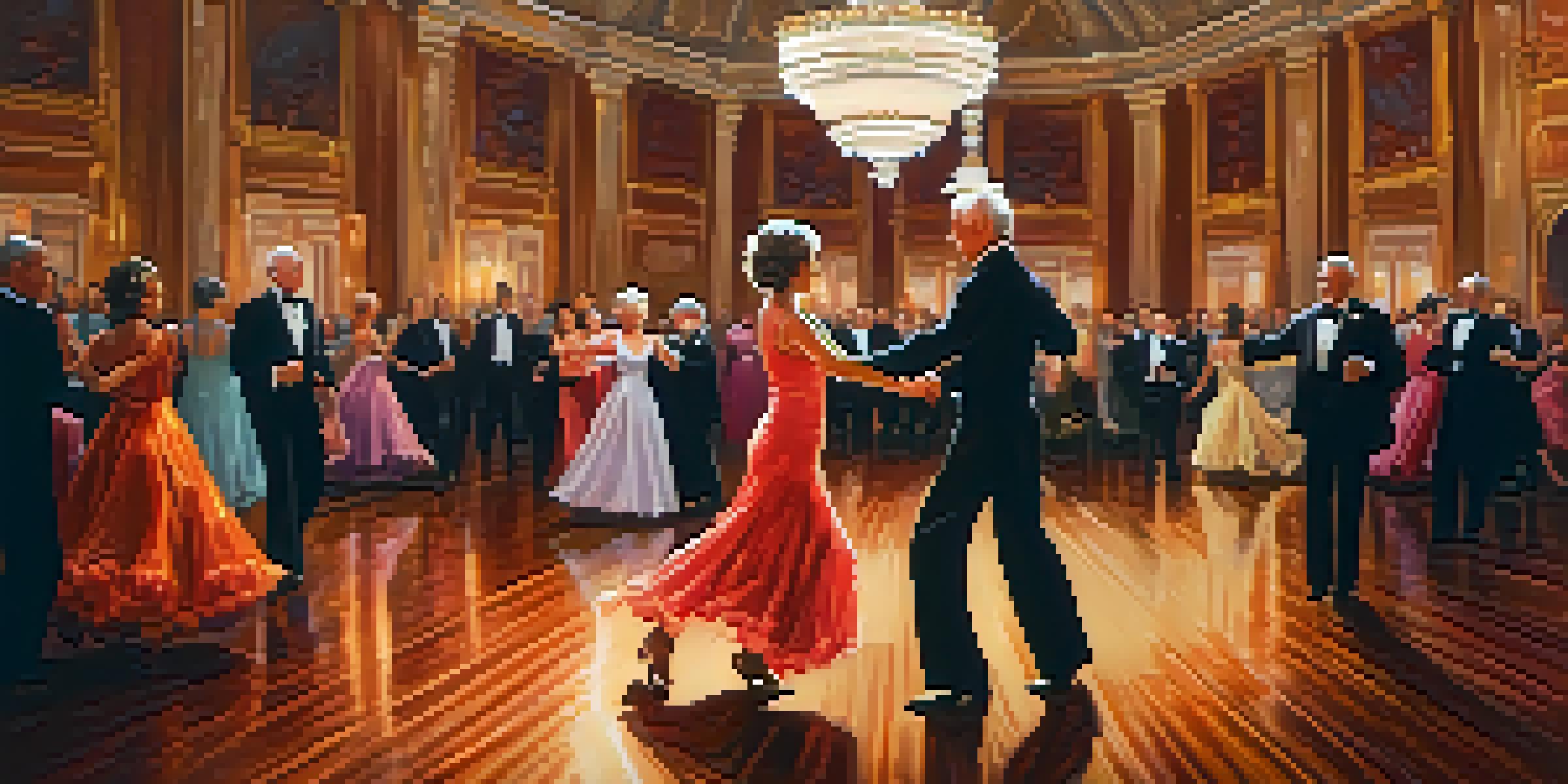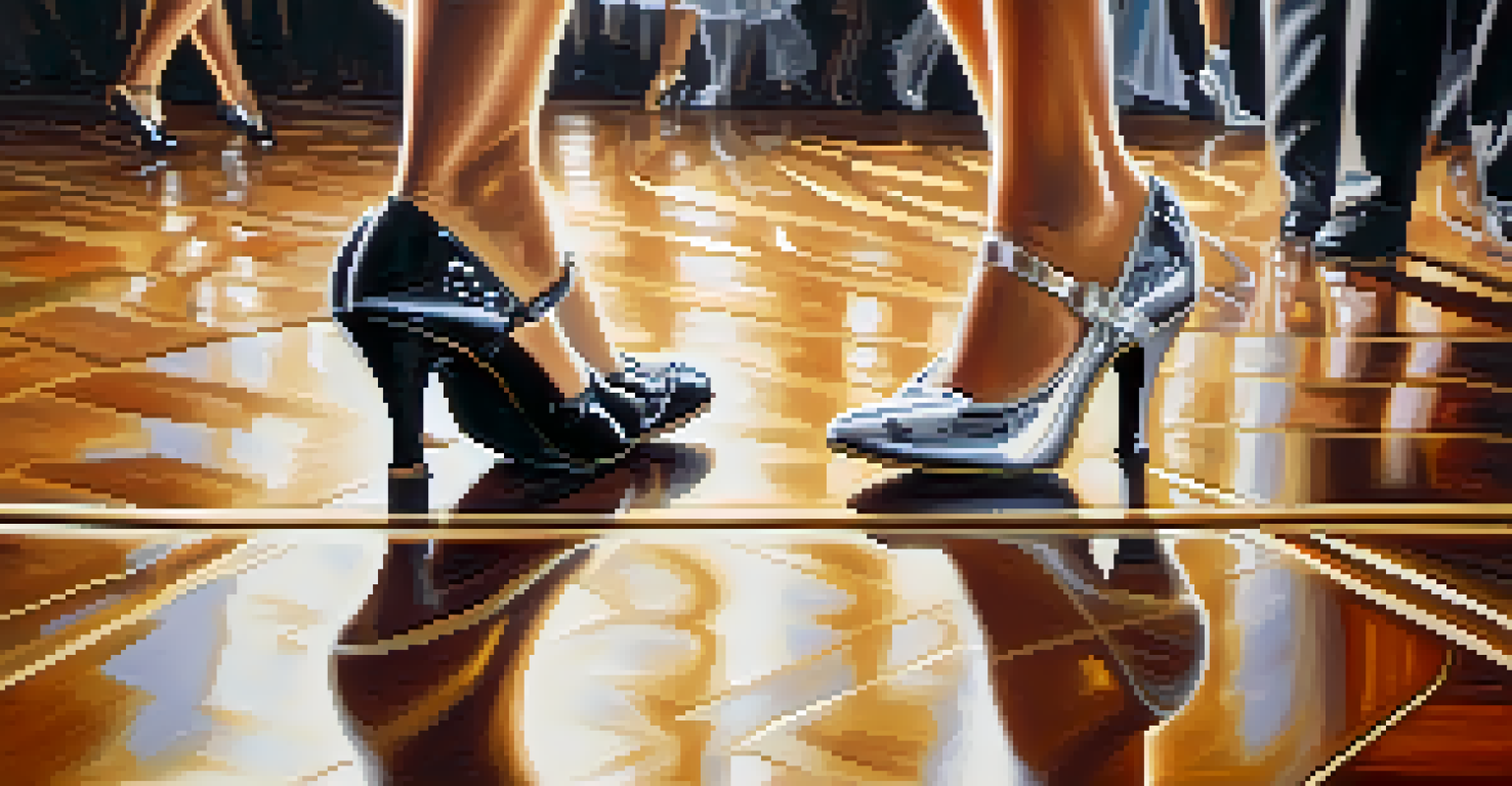The Cognitive Benefits of Dance for Older Adults Explained

Understanding the Connection Between Dance and Brain Health
Dance isn't just a fun activity; it’s a powerful tool for cognitive health. As we age, our brains naturally undergo changes that can affect memory, focus, and overall mental acuity. Engaging in dance stimulates various brain regions, encouraging neuroplasticity—the brain's ability to adapt and grow. This means that regular dancing can help maintain and even improve cognitive functions in older adults.
Dance is the hidden language of the soul.
Moreover, dance combines physical movement with mental challenges, like remembering steps or coordinating with music. This dual engagement activates multiple areas of the brain, making it an effective exercise for both body and mind. By dancing, older adults can enhance their brain's resilience against age-related decline, fostering better cognitive health.
In essence, the connection between dance and brain health is a fascinating interplay of movement, music, and memory. It serves as a reminder that staying active, both physically and mentally, is crucial as we age. So, let’s dive deeper into the specific cognitive benefits dance offers!
Improving Memory Through Dance Activities
One of the remarkable cognitive benefits of dance for older adults is memory enhancement. Learning dance routines requires memorizing steps, patterns, and rhythms, which can significantly sharpen recall abilities. This process encourages the brain to create new connections, making it easier to retrieve memories later on.

For instance, consider a ballroom dance class where participants not only learn moves but also remember the sequence of dances like the waltz or tango. This type of mental engagement can boost both short-term and long-term memory. Regular practice in a social setting also helps reinforce these memories through repetition and interaction.
Dance Enhances Cognitive Health
Regular dancing stimulates brain regions and encourages neuroplasticity, helping to maintain and improve cognitive functions as we age.
Ultimately, dancing serves as a fun and effective way to keep memory skills sharp while also promoting social connections. The joy of sharing a dance with others can create a strong sense of community, making memory improvement a delightful experience.
Boosting Cognitive Flexibility with Dance Moves
Cognitive flexibility is the brain's ability to switch between thinking about different concepts or to think about multiple concepts simultaneously. Dance inherently requires this flexibility, as dancers must adapt to changing rhythms, music styles, and partner movements. For older adults, engaging in dance can enhance this ability, making it easier to adjust to new situations in daily life.
To watch us dance is to hear our hearts speak.
Think about how a line dance might require participants to follow specific steps while also being aware of their surroundings. This kind of multitasking can be mentally stimulating and helps sharpen one’s adaptability. The more varied the dance styles practiced, the more flexible one’s cognitive processes become.
Thus, dance acts as a delightful way to challenge and improve cognitive flexibility, enriching the overall mental experience for older adults. It’s not just about the steps; it’s about fostering a mindset that embraces change and spontaneity.
Enhancing Attention and Concentration through Dance
Attention and concentration are key cognitive skills that can diminish with age, but dance offers a fun avenue to enhance them. When dancing, individuals must focus on the music, their movements, and often their partners too. This heightened focus can lead to improved attention spans over time, as the brain becomes more accustomed to filtering out distractions.
For example, consider a group salsa class where participants must concentrate on the beat and their partner's cues while remembering their own steps. This kind of focused engagement not only makes the dance enjoyable but also trains the brain to maintain attention for longer periods. Over time, this can translate to better concentration in everyday tasks.
Boosts Memory and Attention Skills
Learning dance routines sharpens memory and enhances attention, making it a fun way to keep cognitive skills sharp.
Therefore, incorporating dance into one’s routine can serve as an enjoyable way to sharpen attention and concentration skills. It’s a reminder that mental health can be nurtured through fun activities that challenge the mind.
Fostering Social Connections Through Dance
Social interaction is a vital aspect of cognitive health, and dance provides a unique platform for older adults to connect with others. Participating in group dance classes or social dance events fosters a sense of belonging and community, which is crucial for emotional and cognitive well-being. Engaging with others can help combat feelings of loneliness and isolation that often accompany aging.
For instance, a weekly dance gathering can become a highlight of the week, offering opportunities to meet new friends and strengthen existing relationships. These social bonds not only enhance emotional health but also provide mental stimulation through conversation and shared experiences. The interactions during dance can keep minds active and engaged.
In conclusion, the social aspect of dance is just as important as the physical and cognitive benefits. Building relationships through dance can lead to a richer, more fulfilling life, proving that connection is at the heart of cognitive health.
Using Dance to Combat Cognitive Decline
Cognitive decline can be a daunting prospect for many older adults, but dance offers a proactive approach to combat it. Studies suggest that engaging in regular dance can reduce the risk of developing dementia and other cognitive impairments. The combination of physical activity, mental engagement, and social interaction creates a powerful defense against cognitive decline.
For instance, a study examined older adults who participated in dance classes versus those who engaged in other activities like walking or crafts. The dancers showed significantly better cognitive function over time, highlighting the unique benefits of dance as a multifaceted brain exercise. This demonstrates that making dance a regular part of one's routine can be an effective strategy for cognitive health.
Fosters Social Connections
Participating in dance promotes social interaction, combating loneliness and enriching emotional and cognitive well-being.
Ultimately, by integrating dance into their lives, older adults can take a proactive step towards safeguarding their cognitive abilities. It’s a joyful and engaging way to keep the mind sharp and healthy as the years go by.
The Joy of Dance: A Key Component of Cognitive Health
At the heart of the cognitive benefits of dance lies the sheer joy it brings. Engaging in dance not only stimulates the brain but also elevates mood and promotes a sense of well-being. The euphoric feelings associated with dancing can trigger the release of endorphins, often referred to as 'feel-good' hormones, creating a positive feedback loop for mental health.
For example, think about the last time you danced—whether at a wedding or a casual get-together. The laughter, the music, and the movement combined create an experience that can lift spirits and enhance cognitive function. This joy can make the effort of dancing feel effortless and rewarding, encouraging consistency.

In summary, the joy of dance is an indispensable element of its cognitive benefits. It's not just about the physical activity but also about nurturing happiness, which is crucial for maintaining cognitive vitality as we age.